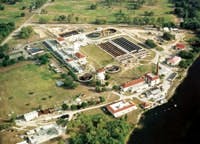For more than 10 years, the Design-Build Institute of America (DBIA) has maintained that the U.S. infrastructure market will see more than 50% of its infrastructure, including water and wastewater facilities, delivered using design-build. DBIA’s forecast is now a reality, as more municipalities are applying this method to execute infrastructure improvements.
The Need to Improve
From the late 1970s through the early 1990s, municipalities throughout the U.S. planned, designed, constructed and began operations of approximately $100 billion in new water and wastewater systems. These systems included treatment plants and underground transmission and conveyance systems, all built to meet Clean Water Act (CWA) and Safe Drinking Water Act regulatory requirements.
At the time, state-of-the-art treatment facilities were built with an intended useful life of 20 to 30 years. The underground utilities were built with a minimum 50-year useful life and designed with the highest level quality in engineering, construction materials and performance. All of the improvements were implemented using the design, bid and build process—otherwise known as a traditional delivery approach.
As we move further into the second decade of the 21st century, these facilities are showing their age and need incremental improvements to extend their useful life. Rotating equipment, instrumentation and controls, and some of the process technologies incorporated into the facilities no longer can meet regulatory requirements or be considered state of the art.
Moreover, the owners of these facilities now face more stringent requirements that will necessitate plant upgrades and dramatic modifications to incorporate more complex technologies. Lastly, an additional array of system improvements is being required for combined sewer overflow (CSO) system abatement under regulated mandates from the CWA.
The U.S. Environmental Protection Agency, the Congressional Budget Office and the American Society of Civil Engineers have concluded that the cost of new water and wastewater infrastructure needed is more than $500 billion over the next 20 years.
The question facing project owners is how to deliver system improvements while minimizing costs, improving system quality and sustainability, determining the best way to implement improvements, and living within more restrictive rate structures and limited support from federal and state governments.
Industry Viewpoints
The argument against design-build and design- build-operate speaks to the heart of the convention for delivery of capital works applied in North America for more than 100 years—that all construction is subject to open, public and transparent bid. This model has been highly successful, but some might say it does not encompass the use of architecture and engineering firms to prepare designs and bid documents, the overall public bidding process or the award of contracts to the lowest responsible bidder. Under this method, called design-bid-build, owners have borne all of the project and contractual risk throughout the useful life of a project while maintaining all control over scope and performance decisions.
The argument for the use of design-build and design-build-operate speaks to the sharing of control, contract and performance risk, while still defining the quality and performance standards of projects. Moreover, design-build and design- build-operate have, with few exceptions, consistently resulted in cost savings, performance risk being taken on by the private sector in the form of the design-build team, and other benefits to owners who are seeking to stretch their fragile budgets while implementing needed improvements.
Design-Build Forecast
Owners are using design-build, design-build- operate and their variants more frequently for new capital improvements. These approaches have brought owners many benefits, including:
• Single-point accountability with innovation in the delivery and technology applied;
• Strong market interest and competitiveness;
• Efficiency related to compressed schedules and ease of transition to full operation and integration of the new facilities;
•Risk transfer by having the design-build/ design-build-operate team provide a firm performance guarantee for the facility; and
• For design-build-operate, owners have defined life-cycle costs over a term that includes all design, procurement, construction over an operations period of generally 10 years or more.
While design-build in the water and waste- water sector started in the 1980s on a limited basis, it now is widely accepted among public and private owners as a proven delivery method. Design-build may not be the only solution to the infrastructure needs identified; however, it is an approach that will continue to grow throughout North America.
It now is widely accepted among major cities and utilities that are addressing large-scale capital improvements for their existing facilities. Some of the capital work is related to replacement of existing infrastructure that has reached or exceeded its useful life.
U.S. Applications
The city of Tampa, Fla., for example, has been using design-build to address an increasing need to fix or replace existing water transmission lines, sewer interceptors and storm sewers. Tampa has achieved the benefits noted above while achieving on-time, under-budget delivery with minimal public disruption. The city and its sister agency Tampa Bay Water also have used design-build and design-build-operate for numerous water treatment plant (WTP) projects: the upgrade of the David L. Tippin WTP, and the delivery of two phases of capacity for a regional WTP that provides service through Tampa Bay Water. The city started the trend throughout Florida, where nearly every major city and utility now employs design-build for similar water projects.
Cities throughout the U.S. that previously did not engage in design-build delivery are pursuing this method. DC Water, the water and wastewater utility for the Washington, D.C., area, is moving rapidly, with more than $1 billion in capital projects using either design-build or design-build-operate. The utility values the single-point accountability, the marketplace competitiveness and the ability to decide which firm or team is most qualified to per- form work for it using design-build.
Other cities increasingly using design-build and design-build operate include Austin, Texas; Cleveland; Colorado Springs, Colo.; Dallas; Denver; Detroit; Houston; Los Angeles; Milwaukee; Philadelphia; Phoenix; San Diego; San Francisco; Santa Fe, N.M.; Seattle; and Tucson, Ariz. Moreover, New York; Chicago; Portland, Ore.; St. Louis; Indianapolis; and Dallas are exploring how best to deploy design-build and design-build-operate for their anticipated infrastructure improvements over the next 10 years.
Why Apply?
Cities are gaining more confidence that design-build delivery makes sense for certain types of projects because the following benefits continue to accrue:
• Cost savings;
• Seamless integration of the improvements into existing facilities;
• Speed of delivery;
• More standard procurement arrangements and contracts;
• Equal or better quality in the delivered project; and
• Minimal claims and litigation compared to traditional delivery.
Lastly, industrywide communication of best practices by managers, architectural and engineering firms, cities and procurement advisors have brought the knowledge base to where it is today such that design-build, design-build-operate and their variants no longer are referred to as “alternative delivery.” These techniques are here to stay, as evidenced by the number of project owners deploying them.
Download: Here


